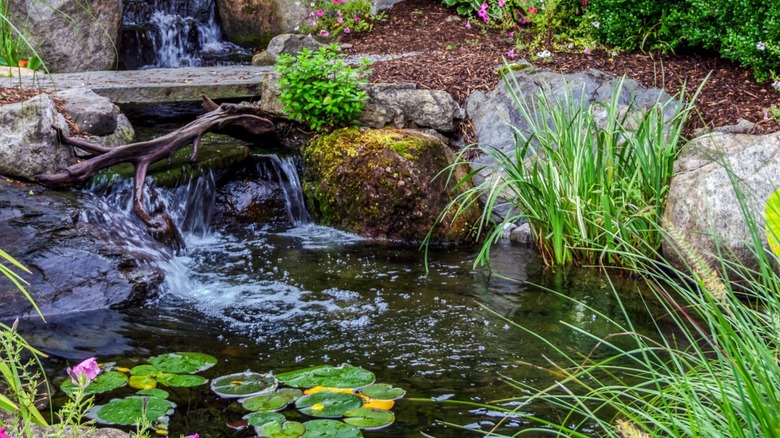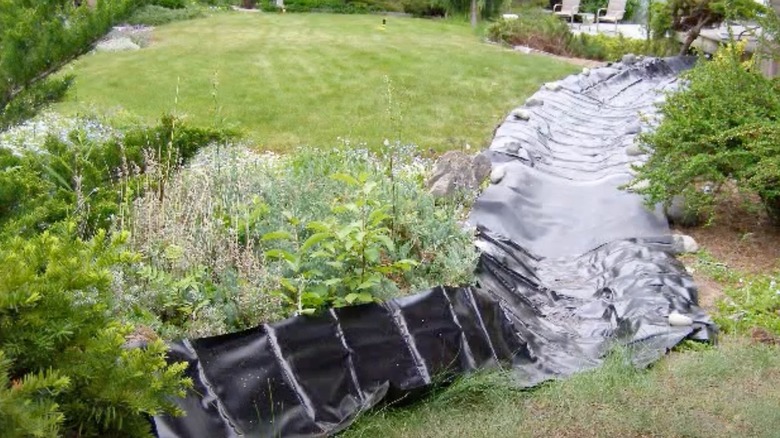Create A Backyard River To Add Interest And Organic Water Movement To Your Space
We may receive a commission on purchases made from links.
Imagine waking up in the morning, enjoying your favorite cup of coffee, and walking out to your backyard where you are greeted by the soft babble of a small stream. The sun glints off the surface of the water, adding a bit of magic to your personal oasis. Though this may seem far from reality, building a backyard river is actually an attainable endeavor. All it takes is a few steps: designing a plan, digging a trench, covering it with a lining, adding a submersible pump, and decorating it with plants or stones. It's a fun project that may add value to your home and, once installed, is pretty low maintenance. The sound of running water in a backyard stream can also reduce noise pollution and provide the perfect ambience for a meditation garden. These are just a few of the reasons why you should add an outdoor water feature to your landscaping.
To begin this project, there are a few steps you should take before breaking ground. First, double-check with your state guidelines to see if a permit is necessary for building recreational bodies of water. Another thing to consider is if your backyard is on any type of slope. Believe it or not, putting in a water feature is an awesome way to design your sloped backyard. Next, map out the size and length of the stream. We recommend using a water hose to better visualize the shape and size. It may be smart to take photos of your ideas after arranging so you can compare them to see what works best. Then, you can start building your backyard stream.
Digging the basin and lining the stream
Once you have a design that works, mark the length and width of the river with rocks to help keep track of the shape and size while you dig. You'll want to create a basin that is at least 6 to 12 inches deep. Also be sure to dig a hole at the end of the stream to house the pump. When the trench is completed, line the basin with an underlayment and flexible pond liner. This will help prevent land erosion and prevent the water from getting muddy. We recommend UWIOFF pond liners which can be purchased on Amazon for as little as $14. Make sure the liner is smoothly covering both the basin and the trench. Use rocks to hold it in place and trim any excess liner that may be sticking out.
After the stream is dug and lined, it's time to purchase the pump; one option is Aquaspace's submersible pumps. They have a built-in filter feature which helps with keeping maintenance at a minimum. There are two parts to be conscious of during installation. The first is the wire which will need to be connected to a power source. An extension cord may be necessary depending on the distance of the stream from your home. The second is the return pipe/hose that the water will flow through to create water movement in the stream. The hose should be a little bit longer than the length of the stream itself so you can have proper water flow.
Installing the pump and finishing touches
To install the pump, simply place it in the hole you made when you dug the trench. You'll want to lay the hose or pipe alongside your stream to the opposite end, turning the mouth back into the top of the stream to create water recirculation. Test how the pump runs by filling the hole with water and plugging it in. Keep in mind that the water will look dirty at first until it has been filtered enough times.
If you are happy with how things are looking, begin to build up the landscape around your stream. Add decorative rocks and pebbles in and around the water to keep the lining in place and hide the hose. You may want to keep the stream running while putting down your rocks to determine the best place for each one. Also bury the hose or pipe in the ground so it's not visible. Plants and rocks can also help disguise the hose as well. Over time, you can continue to customize the space with an LED lighting system, garden statues, or even stepping stones depending on the depth of your basin. If the river is large enough, consider adding aquatic-friendly plants to your water feature. This will help create a luscious environment and will mask the pump and liner to keep everything looking natural.

